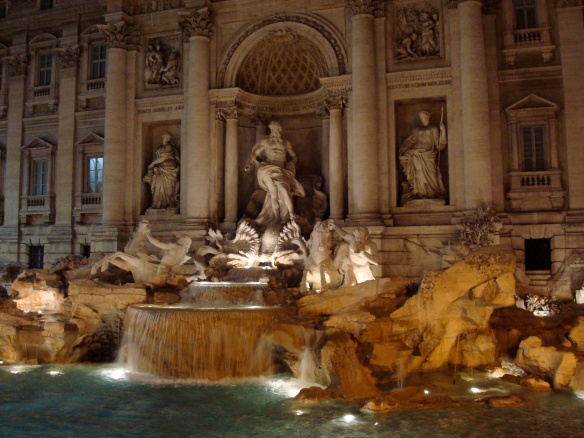
In 2007, my understanding of what it means to be inspired changed.
In 2007, we spent Christmas in Rome.
After what had been a difficult year, with any number of challenges seeming to hit in rapid succession, one after another, including the death of my grandfather, the idea of leaving to Rome at the end of December was equal parts daunting and exciting. A much-needed break ultimately tipped the scales in favor of deciding to go, but the weeks leading up to our departure grew increasingly hectic. I think we all experience those times when it feels as though everything is happening all at once, that there seems to be a cyclical nature to the frequency of when the difficulties pile up, and it had definitely been that kind of year. In the month leading up to our departure, arranging for plane tickets, hotel, tours, and dinners in Rome was a welcomed distraction. And by the time mid-December rolled around, we were ready to get out of Dodge.
We flew non-stop from Phoenix to London. 9 hours. In coach. Ok, ok, it wasn’t that bad actually. Was it a bit cramped being that we sat in the 2 middle seats in the middle row? Ummmm….yes. But we flew at night on purpose, and crossing the Atlantic in a cool, quiet, dark airplane is, I would imagine, considerably more pleasant than if it had been the opposite. Plus, the excitement of finally being on our way helped make the plane ride even more manageable. The layover in London was fine, and although I could sense that my circadian clock was ticking oddly, I was enjoying the trip already. I think getting a little physical distance between me and the everyday grind was not only a relief, but it also revealed just how much on auto-pilot I had been functioning.
A 2-hour plane ride to Rome, a 30-minute train ride, and several escalators later, we emerged from the Metro station in Piazza Barberini. It was around 8:30 at night, and drizzling. Our hotel was a short, yet confusing walk just around the corner. Three flights up a winding staircase, through a frosted glass door, the desk clerk, an Australian also named Steve, greeted us warmly and showed us to our room.
“Before you unpack,” he suggested, “take a walk down to the fountain.”
At first, the suggestion seemed a bit odd. We had been traveling for the better part of 15 hours. But whatever thoughts I may have had not to go were fleeting; we were in Rome afterall, and I didn’t just fly half-way around the world to sit in a hotel room. We set down our bags, washed up a bit, and headed back out. Down the winding staircase, out the door, and to the left. Steven had given us a map, marking the route of our 5 minute walk. The rain had mostly subsided, and the giddiness had kicked in.
The streets of Rome were quiet, for the most part. Narrow cobblestoned roads were lined with small shops and restaurants, and there were smatterings of people walking around too, but no crowds, no chaos.
The map showed that we were getting closer, and then about a block or 2 away, a faint wooshing sound could be heard. As we drew closer, still unable to see it, the wooshing grew louder, and the sound of flowing water filled the air. We walked down the Via del Lavatore, crossed the Via dei Lucchesi, and saw this, the Trevi Fountain….

There was almost no one around. Words left me. I don’t think I had ever seen any man-made thing as beautiful. And while I’m not one to exaggerate things or jump to unrealistic conclusions, I was keenly aware that what I felt inside me at that moment was inspiration unlike any I had ever felt before, and that this was going to be an amazing trip.





 Of course, it isn’t Caravaggio’s lifestyle or violent tendencies that inspire me. What I find fascinating, what I find inspirational, is that a man who lived so fast, with so much tumult, and with such anger, could also create such beauty, redefine the direction of art, and perfect a technique that is so characteristically his own. Caravaggio’s style, especially in his later works, are focused on a more realistic depiction as opposed to the histrionic implements of many other Renaissance artists. But it isn’t just the realism that is striking, it is the use of light and dark. His paintings seem to give off light, and yet be incredibly dark. In his paintings like
Of course, it isn’t Caravaggio’s lifestyle or violent tendencies that inspire me. What I find fascinating, what I find inspirational, is that a man who lived so fast, with so much tumult, and with such anger, could also create such beauty, redefine the direction of art, and perfect a technique that is so characteristically his own. Caravaggio’s style, especially in his later works, are focused on a more realistic depiction as opposed to the histrionic implements of many other Renaissance artists. But it isn’t just the realism that is striking, it is the use of light and dark. His paintings seem to give off light, and yet be incredibly dark. In his paintings like




 I don’t know if it’s a secret. But there is nobody in Rome during Christmas. There were tens of thousands of people in St. Peter’s square for midnight mass, and at least twice that many people there Christmas morning…but to be honest, I have no idea from where they came. There were no exorbitant lines at the Vatican museums, the Coloseum, or any of the other churches or museums we toured. I only bring this up to further demonstrate how much this added to Rome feeling intimate and personal. The access we had to the spirit of Rome, not by way of throngs of tourists or half-day sprints from landmark to landmark, but in a relaxed, steady, almost private pace that allowed the experience to feel more like reading a great book than being in a foreign country or city.
I don’t know if it’s a secret. But there is nobody in Rome during Christmas. There were tens of thousands of people in St. Peter’s square for midnight mass, and at least twice that many people there Christmas morning…but to be honest, I have no idea from where they came. There were no exorbitant lines at the Vatican museums, the Coloseum, or any of the other churches or museums we toured. I only bring this up to further demonstrate how much this added to Rome feeling intimate and personal. The access we had to the spirit of Rome, not by way of throngs of tourists or half-day sprints from landmark to landmark, but in a relaxed, steady, almost private pace that allowed the experience to feel more like reading a great book than being in a foreign country or city.



